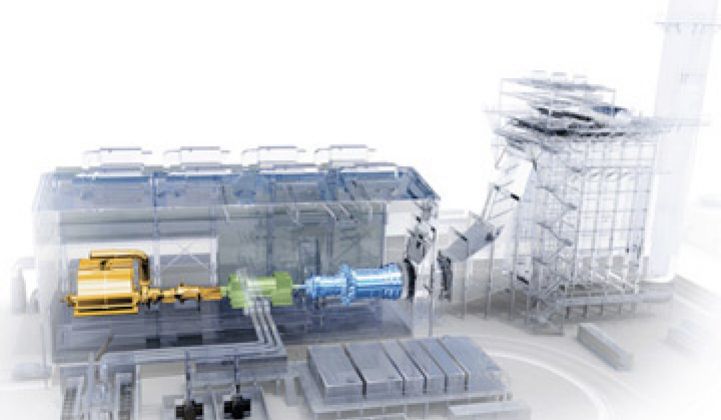I still have no idea why Ellie the Elephant is dancing in the General Electric ecomagination commercial. The heartwarming, if vague, commercial is cute, yet it almost smacks of greenwashing. If I buy a GE turbine, will I save an elephant? However, the wide-ranging program by GE is anything but fluffy.
The strategy, which reaches into all areas of GE’s business, has generated $85 billion in revenue since 2005 and ecomagination sales are expected to grow twice as fast as the rest of the company. The global giant introduced 22 new ecomagination products and solutions in 2010, for a total of 110 overall.
This year is looking to be no different. In 2011, GE has released five products, which join a group that includes everything from a WattStation electric vehicle charger and Voluson Compact Ultrasound to an Ultra-Efficient Transformer and PowerHaul Locomotive.
Here are the latest additions to the portfolio:
FlexEfficiency 50/9FB
The new 510-megawatt combined-cycle power plant that offers fuel efficiency greater than 61 percent is the result of an investment of more than $500 million in R&D by GE.
GE drew from the company’s jet engine expertise to engineer a plant that will ramp up at a rate of more than 50 megawatts per minute.
However, Greentech Media reported that the ramp rate might not be that impressive, according to Jim Detmers, former COO of the California Independent Systems Operator. "We can currently ramp generators at 63 megawatts per minute," but "early studies show that we need over 400 megawatts per minute to cope with a 33 percent RPS," according to Detmers. "We need new technology," he concludes.
Any improvement in natural gas-fired plants will help with integrating more renewables on the grid, and GE is sure to refine the technology to gain market share in a growing sector.
CO2 Compression
Carbon capture and sequestration is still elusive in terms of cost and technology, but that’s exactly why GE is working on it. Its CO2 compressor and pump-integrated system can reduce electricity consumption by about 6 percent when it’s used for CCS or by about 16 percent when it’s used for enhanced oil recovery.
CCS might still be a ways off in the future, but CO2 injection is the most popular type of enhanced oil recovery in recent years, according to the Department of Energy. Projects in more than 11 states are using CO2, either from naturally occurring reservoirs or from industrial applications, to drive more oil out of wells. With a focus on energy security, corporations will only be using more of these techniques in the years ahead, so there is a need for them to be as efficient as possible.
CleanCycle
Waste heat is arguably one of the most available sources of energy, and yet it’s barely been tapped. GE is working on that, too. Its small-scale power generation systems run on waste heat from reciprocating engines, biomass boilers or micro turbines and then reuse it in the machine. Potentially, the energy could also be sold back to the grid.
In 2008, researchers at UC Berkeley estimated that the U.S. consumes 100 quadrillion BTUs, or quads, of energy a year, and that 55 percent to 60 percent of those quads get dissipated as waste heat. For example, Michael Kanellos recently noted that the Wartsila-Sulzer two-stroke diesel engine for ships is considered one of the most efficient in the world: half of the energy gets converted to waste heat.
Motors seem to be on everyone’s minds these days. ABB has recently focused on electric motors, which they argue consume 45 percent of all electricity produced in the world. Data centers are another area that companies are focusing on to reduce or recycle waste heat.
AC441 South American Locomotive
Trains, especially freight locomotives, can often seem like technological relics from another century. However, controls have changed dramatically over the years and GE continues to invest in rail. This latest freight train for the South American market is 20 percent more efficient than its counterparts.
Using freight is always more fuel-efficient than hauling by truck, according to the U.S. Federal Railroad Administration. The AC44i goes even further with one less one locomotive needed to haul a load that previously would have taken five locomotives to move. This isn’t your grandfather’s freight train.
MapFrame
Technology is slowly but surely coming to the utility industry -- and GE is on board. While some utilities are still a paper-heavy business (we hear water utilities are particularly outdated), GE’s MapFrame is just one mobile incarnation to sweep utility field workers into the 21st century.
This rough- and tough-looking iPad can help workers in the field with real-time information and report back to the office. The technology actually came through a 2008 acquisition. At the time, MapFrame already outfitted 35,000 workers across 30 U.S. utilities.
Acquisitions and partnerships like this, especially in the smart grid space, are likely only to increase for General Electric. On Thursday the GE Ecomagination Challenge will announce the winners of its second round of competition. After the first round, there were 12 winners, one of which, FMC-Tech, has already been acquired by GE. The latest round is solutions for the home area network, and although GE already has its own home energy management system and a suite of smart appliances, it is surely using its Ecomagination Challenge to shop for some more offerings to add to the mix.
Editor's Note: The original article misstated that the new locomotive could do the work of five old locomotives, when in fact it cuts down on the need by one.



